Redington recently announced the discontinuation of their popular Hydrogen rod series, which has long been one of the brand’s most popular rods. Few companies, though, are willing to stand pat with their lineups these days, especially where fly rods are concerned. And that’s why we have the new Redington TRACE on rod racks in fly shops across the country.
The TRACE, much like the Hydrogen, is supposed to serve as Redington’s do-it-all fly rod, capable of handling any and all trout situations. The TRACE has a medium-fast action that slows up nicely when throwing at distance. The rod has plenty of power in the blank, which helps to both turn over heavy rigs and move big fish.
But is the TRACE really a do-it-all rod? That depends largely on how you plan to fish it.
What Works
Action
As noted above, the Redington TRACE sports a solid medium-fast action that will be familiar to those that have cast any number of Redington rods over the last few years. It may be a tad slow for folks who like the really fast sticks, but for most trout anglers, the pleasant casting rhythm of the TRACE will be easy to pick up on.
I like lawn-casting rods before I take them on the water — a literal dry run, if you will. When lawn-casting the 9’ 5wt TRACE on my in-laws’ lawn, I was pleasantly surprised at how easily I could pick up and throw 60 feet of line. For a rod that retails at $299.99, I had to work a lot less than expected to get the rod to behave with what I wanted to do.
When casting real flies to fish on the Henry’s Fork and Green River, things felt similar to my lawn-casting session. The rod moves line quickly, and it was easy to punch out an extra 15-20 feet for longer casts.
Backbone
It’s the time of year when I fish a hopper-dropper-dropper rig everywhere (well, where three flies are permitted, of course). A lot of 5wts don’t like to cooperate when I ask them to throw that many extra flies and feet of tippet, but the TRACE handled my demands admirably. Long casts with three flies weren’t pretty, but they landed where I aimed.
The TRACE won’t power effortlessly against heavy winds, but it’s not useless in gusty conditions, either, the way some softer rods tend to be. Where the TRACE’s backbone really surprised me was in how well I was able to move big fish in strong current. I spend a lot of time on the A-Section of Utah’s Green River. This section of river has about 12,000 trout per mile that average 17 inches long. It’s in a steep, narrow canyon and fishes best at 2,000cfs or so. Catching an average trout in that current puts a lot of rods’ fish-fighting abilities to the test, and the TRACE outkicked its coverage here. I didn’t have a problem putting pressure on 20-inch rainbows and forcing them into the net, even against heavy current.
Tippet Protection
The TRACE has a tip soft enough to protect lighter tippet. While I wouldn’t feel confident fishing tippet lighter than 6x on it, most folks using a 9’ 5wt aren’t likely to go down that small on tippet anyways. For the vast majority of your trout fishing situations, the tip on the TRACE is soft enough to absorb vigorous headshakes and long runs by bigger fish. And, if you get into some finicky trout that are leader-shy, you won’t need to worry about tying on that 6x fluorocarbon.
Build Quality
Redington has put out some interesting rods in recent years – remember the Vapen series, with the golf club grips? Those were met with mixed reviews, and the grip on their Crux rod is the subject of debate in fly shops and bars across the country.
Redington didn’t do anything crazy with the TRACE, thankfully. It looks an awful lot like their Classic Trout rod – another wildly popular stick the company hasn’t messed with, and shouldn’t. The TRACE is finished in a matte mahogany that glints nicely in the sun. Paired with matching thread wraps, alignment dots on each section, and single-foot guides, the TRACE offers a classy, pleasing aesthetic.
The reel seat is actually wood – it’s just stained incredibly dark. At first, I thought Redington opted for a carbon reel seat insert, but in the sunlight, you can see the grain of whatever wood Redington uses here.
The cork, while not what you’d find on $900 and $1000 flagship rods, is quality and plenty soft enough to be comfortable for a day’s worth of fishing.
Also of note is that the rod, in a 9’ 5wt configuration, clocks in at 2.8 ounces, which is wonderfully light.
What Doesn’t
Casting in Close
I had high hopes for the Redington TRACE as a dry-fly rod, and for the most part, it met those expectations. A few of my fishing buddies who spent time with it remarked on how well the TRACE threw dries, and I took note of that as well.
Where it falls a bit short, though, is in-close. And by in-close, I mean those really short casts when you’re standing in the middle of a river and a fish starts rising 15 feet away. Occasionally, I had trouble getting the TRACE to load and accurately deliver casts inside that range.
The reason the tip. Redington specifically stated they added more power to the tip of the TRACE than what anglers found in the old Hydrogen rods. Doing so sacrificed how well the rod could perform at shorter distances.
Some anglers, specifically those that felt the Hydrogen lacked in tip power, will appreciate the change. Others, who like to fish small flies in close, may not.
Final Word
Redington has put together a very solid offering with the TRACE. It’s light, casts wonderfully from 20-60 feet, and has the backbone to handle big fish, big flies, and wind. The 9’ 5wt is very close to being a true do-it-all rod, and it surprised me with its accuracy and light weight. The build quality exceeds what I expected from a $300 rod, and I really like the matte mahogany finish on the blanks. In fact, the only thing I’d change about the TRACE is the increased power in the tip, though that’s a change that other anglers may appreciate.
At $299, the TRACE is poised to follow in the Hydrogen’s footsteps as one of Redington’s most popular rods.





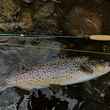
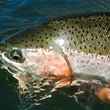



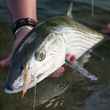



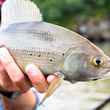




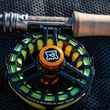




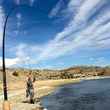




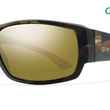
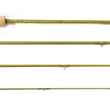
Comments